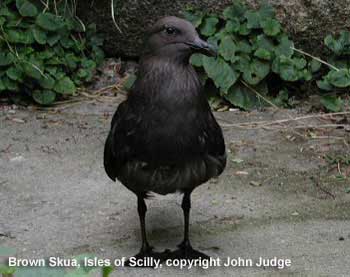
| EMAIL THIS PAGE TO PALS |
Don't Miss a Beat. Join the thousands of subscribers and get all the Latest World Birding News delivered FREE to your inbox weekly! Enter your email address below to subscribe. It's that easy!

A POTENTIAL NEW BIRD SPECIES FOR EUROPE: RESULTS OF DNA ANALYSES ON TWO CONTROVERSIAL SKUAS
Two Catharacta skuas, one discovered at St. Agnes in the Isles of Scilly in October 2001, the other on Aberavon Beach in Glamorgan, South Wales in February 2002, have provoked considerable debate as to their identity. Both were unwell and taken into care allowing feather samples to be collected from which DNA was extracted. Results of analyses conducted at the University of Glasgow show that both individuals belong to the Brown Skua group Catharacta antarctica (lonnbergi/hamiltoni/antarctica). Further, the measurements of the Glamorgan bird suggest that it may be a Falkland Skua C. a. antarctica. However no measurements were obtained from the Scilly bird.
As with all additions to the British list this record requires review by BOURC and BBRC. However the genetic analyses are conclusive. Therefore this is a sensational and unexpected result that could have enormous repercussions for the identification of large skuas in the north Atlantic, particularly since skua watchers in Europe and Eastern North America have tended only to consider Great Skua Catharacta skua and South Polar Skua Catharacta maccormicki as serious options. It is for this reason that we are releasing the information into the public domain prior to any formal publication of these findings.
The reason that large skua identification is so difficult is that, apart from them all being closely related and that they are very variable, they are all pelagic between the times that they are juveniles and their return as much older birds to their breeding grounds. Thus young immature birds are seldom seen in collections nor are they photographed with a verifiable identification. These 2 birds provide a valuable yardstick against which further progress can be made.
Pictures of these birds can be seen here:
http://www.magikcircle.com/birds/image.asp?title_id=574
There is also a paper on the moult of the Scilly skua here:
/mb/Features/skua-identification.html
Acknowledgements
A number of people can take credit for providing discussion, caring for the birds, collecting samples and taking photographs:
Rick Barrowman, Dean Bolt, David Carrington, John Clare, Neil Donaghy, Lee Evans, Paul Guris, Anne Hardeman, Paul Harvey, David Hatton, Julian Hough, David James, Frédéric Jiguet, Tony Marr, Anthony McGeehan, Killian Mullarney, Kate Orr, Richard Porter, Martin Reid, Martin Renner, Richard Smith, Barry Stewart, Simon Stirrup, Mike Tove, and Gower Bird Hospital for nursing the Glamorgan bird to release.
There are lessons in this story for anyone who finds an odd-looking large skua. After the welfare of the bird has been assured, photograph it, measure it and take a DNA sample.
We would like to receive photographs of immature southern skuas, particularly Falkland Skuas, in order to corroborate these results further. Please send to Dick Newell at dick.newell@macunlimited.net
This release was assembled from contributions by:
Dick Newell
Steve Votier
Stuart Bearhop
Bob Furness
Martin Kennedy
Martin Scott
Paul Dukes
Steve Moon
Jed Andrews at Holme N.O.A